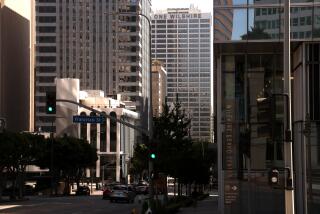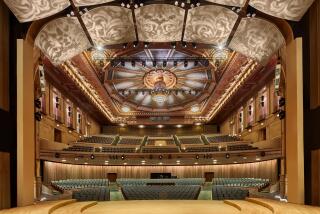Samsung campus latest sign of life in Silicon Valley’s architectural wasteland
- Share via
First-time visitors to Silicon Valley are inevitably disappointed when they arrive at the world’s leading center of innovation.
For all the amazing technological breakthroughs this region has produced, for all the disruptive products launched from here, the region’s architecture is less than an after-thought. From south of San Jose, stretching up the Peninsula through South San Francisco, Silicon Valley is an architectural wasteland. The notable exception is the Stanford University campus in Palo Alto
It’s a shame, really. The peninsula and South Bay offer natural beauty, with rolling hills to the west and the San Francisco Bay to the east. But rather than complement those wonders, this high-tech hub has mostly been sandwiched in an unending string of dreary office parks full of two-story cubicle-lined buildings whose main visual goal seems to be to escape all notice.
PHOTOS: Tech we want to see in 2013
But suddenly, Silicon Valley has shown signs of becoming an architectural hot spot. No one is about to confuse the place with Paris. But the latest evidence of this trend came very quietly in December, when Samsung Inc.’s semiconductor division released renderings of a new facility it plans to build in North San Jose.
While Samsung had announced its intentions to build a new facility back in August, there were only bare details revealed at the time. In December the company updated the plans with a series of renderings that show its intent to construct an unusual and distinctive landmark.
“It would definitely be a signature building for San Jose,” said Joseph Horwedel, the city’s director of planning. “It’s a design for a campus that has a lot of green woven into it. It’s not just check-the-box green types of things.”
The building will be one of the taller buildings in a region that gets nervous about any building that has three floors. Samsung’s main building will have ten stories.
The above photo shows the main tower. One of the unusual features is that it is actually a series of two-story buildings stacked on top of each other. The floors in between, where the building appears to narrow, are actually open green spaces. There are no outside walls on those green floors. They are essentially parks located between the actual office floors.
The building is designed to be green and lush, both from an environmental standpoint, but also in terms of giving employees a feeling they are connected to the outdoors at all times.
“Conceptually, Silicon Valley is a very fertile valley,” said Jonathan Ward, a design partner at the Los Angeles office of NBBJ, which designed the building for Samsung. “For centuries it is has provided fertile soil for fruits and vegetables. And for the last couple of generations, it’s been fertile ground for innovative ideas.”
“Steve Jobs talked about his connection to the outdoors. So we said, ‘Let’s take that approach. Let’s make sure every employee has access to the outdoors within one floor.’ So we took a series of two-story buildings and stacked them on top of each other, and put gardens in between them.”
If you look down into the main tower, it contains another big green space in the form of a courtyard (above). The main tower is connected to adjacent story buildings through a series of see-through walkways (below). And the sides of the shorter buildings will be draped with greenery, and topped by solar panels.
Samsung has long had its U.S. semiconductor headquarters based in a typical San Jose office building. As it sought to expand, it flirted with moving to Austin, Texas. But San Jose and Gov. Jerry Brown’s office offered significant incentives for the company to stay. Last August, the deal was announced with great fanfare at a ceremony attended by Brown.
The building will be 680,000 square feet and will eventually house R&D; operations and sales offices for 600 employees. The current buildings that Samsung occupies on the site will be torn down and the 300 or so employees there now will be temporarily relocated until the new facility opens in 2015.
When the deal was announced, no architectural plans had been submitted. San Jose didn’t know what it was getting in terms of design. But Chris Goodhart, a Samsung spokeswoman, said the company wanted a building that reflected its innovative spirit.
“We make some of the most innovative components that are going into the latest consumer and IT products, “Goodhart said. “So the campus should reflect that.”
She also noted that the company hoped the campus would be an advantage in recruiting and retaining employees in Silicon Valley’s highly competitive job market.
In terms of architectural eye candy, though, the new Samsung campus will have plenty of rivals in the coming years.
The most buzzed-about, of course, has been the new Apple Inc. campus in Cupertino:
Over in Menlo Park, Facebook Inc. hired legendary architect Frank Gehry to design its new campus:
And down the road a bit, the city of Santa Clara will soon be home to the new San Francisco 49ers stadium:
While Samsung is getting a signature building, that wasn’t the first thing the company requested, Ward said. Instead, it wanted the architects to start the process by rethinking what happened inside the work spaces.
In addition to looking different, Ward said, Samsung was interested in a place that encouraged people to work differently as well.
The campus parking garages are largely hidden, rather than sprawling lots. And it’s close to public transportation lines.
Ward described the see-through walkways that connect the main buildings as “activated” because they will contain things like a gym and meeting and social space -- spaces designed to draw people out of their cubicles to interact with people from other parts of the company.
“I think the design of the inside of the structure is becoming more important to these companies for sure,” Ward said. “What’s happening inside the building is different. The companies we’re working for are demanding something that’s different. More community, more connectivity, more synergy.”
“I think if you start with that approach it will lead to some really powerful expressions on the outside. It’s allowing companies to rethink interactions inside that lead to different ideas.
“And maybe people have had a enough of plain-vanilla buildings.”
ALSO:
Exxon tops Apple as most valuable company
Samsung to launch 5.8-inch phone dubbed ‘Fonblet’?
Samsung takes pre-orders for Ultra HD TV in Korea priced at $38,000
Follow me on Twitter @obrien.
More to Read
Inside the business of entertainment
The Wide Shot brings you news, analysis and insights on everything from streaming wars to production — and what it all means for the future.
You may occasionally receive promotional content from the Los Angeles Times.











